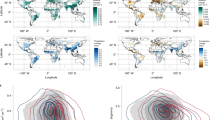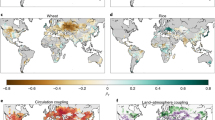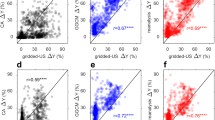Abstract
Understanding the response of agriculture to heat and moisture stress is essential to adapt food systems under climate change. Although evidence of crop yield loss with extreme temperature is abundant, disentangling the roles of temperature and moisture in determining yield has proved challenging, largely due to limited soil moisture data and the tight coupling between moisture and temperature at the land surface. Here, using well-resolved observations of soil moisture from the recently launched Soil Moisture Active Passive satellite, we quantify the contribution of imbalances between atmospheric evaporative demand and soil moisture to maize yield damage in the US Midwest. We show that retrospective yield predictions based on the interactions between atmospheric demand and soil moisture significantly outperform those using temperature and precipitation singly or together. The importance of accounting for this water balance is highlighted by the fact that climate simulations uniformly predict increases in atmospheric demand during the growing season but the trend in root-zone soil moisture varies between models, with some models indicating that yield damages associated with increased evaporative demand are moderated by increased water supply. A damage estimate conditioned only on simulated changes in atmospheric demand, as opposed to also accounting for changes in soil moisture, would erroneously indicate approximately twice the damage. This research demonstrates that more accurate predictions of maize yield can be achieved by using soil moisture data and indicates that accurate estimates of how climate change will influence crop yields require explicitly accounting for variations in water availability.
This is a preview of subscription content, access via your institution
Access options
Access Nature and 54 other Nature Portfolio journals
Get Nature+, our best-value online-access subscription
$29.99 / 30 days
cancel any time
Subscribe to this journal
Receive 12 digital issues and online access to articles
$119.00 per year
only $9.92 per issue
Buy this article
- Purchase on Springer Link
- Instant access to full article PDF
Prices may be subject to local taxes which are calculated during checkout



Similar content being viewed by others
Data availability
SMAP science data are available at the NASA National Snow and Ice Data Center Distributed Active Archive Center (https://nsidc.org/data/smap). Meteorological data are available at the PRISM Climate Group at Oregon State University (http://prism.oregonstate.edu). Maize yield data are available at the US Department of Agriculture/National Agriculture Statistics service (https://www.nass.usda.gov). Observations from the US-Ne3 eddy covariance site are available at the AmeriFlux (soil moisture; http://ameriflux.lbl.gov) and FLUXNET2015 (VPD, GPP and solar radiation; http://fluxnet.fluxdata.org/) data repositories.
References
Butler, E. E. & Huybers, P. Variations in the sensitivity of US maize yield to extreme temperatures by region and growth phase. Environ. Res. Lett. 10, 034009 (2015).
Handmer, J. et al. in Managing the Risks of Extreme Events and Disasters to Advance Climate Change Adaptation (eds Field, C. B. et al.) 231–290 (IPCC, Cambridge Univ. Press, 2012).
Lobell, D. B., Bänziger, M., Magorokosho, C. & Vivek, B. Nonlinear heat effects on African maize as evidenced by historical yield trials. Nat. Clim. Change 1, 42–45 (2011).
Lobell, D. B. et al. The critical role of extreme heat for maize production in the United States. Nat. Clim. Change 3, 497–501 (2013).
Porter, J. R. et al. in Climate Change 2014: Impacts, Adaptation, and Vulnerability. (eds Field, C. B. et al.) 485–533 (IPCC, Cambridge Univ. Press, 2014).
Schlenker, W. & Roberts, M. J. Nonlinear temperature effects indicate severe damages to U.S. crop yields under climate change. Proc. Natl Acad. Sci. USA 106, 15594–15598 (2009).
Zhao, C. et al. Temperature increase reduces global yields of major crops in four independent estimates. Proc. Natl Acad. Sci. USA 114, 9326–9331 (2017).
Butler, E. E. & Huybers, P. Adaptation of US maize to temperature variations. Nat. Clim. Change 3, 68–72 (2013).
Basso, B. & Ritchie, J. T. Temperature and drought effects on maize yield. Nat. Clim. Change 4, 233 (2014).
Fezzi, C. & Bateman, I. The impact of climate change on agriculture: nonlinear effects and aggregation bias in Ricardian models of farmland values. J. Assoc. Environ. Resour. Econ. 2, 57–92 (2015).
Anderson, C. J., Babcock, B. A., Peng, Y., Gassman, P. W. & Campbell, T. D. Placing bounds on extreme temperature response of maize. Environ. Res. Lett. 10, 124001 (2015).
Carter, E. K., Melkonian, J., Riha, S. J. & Shaw, S. B. Separating heat stress from moisture stress: analyzing yield response to high temperature in irrigated maize. Environ. Res. Lett. 11, 094012 (2016).
Carter, E. K., Melkonian, J., Steinschneider, S. & Riha, S. J. Rainfed maize yield response to management and climate covariability at large spatial scales. Agric. For. Meteorol. 256–257, 242–252 (2018).
Rosenzweig, C., Tubiello, F. N., Goldberg, R., Mills, E. & Bloomfield, J. Increased crop damage in the US from excess precipitation under climate change. Global Environ. Change 12, 197–202 (2002).
Schauberger, B. et al. Consistent negative response of US crops to high temperatures in observations and crop models. Nat. Commun. 8, 1–9 (2017).
Shaw, S. B., Mehta, D. & Riha, S. J. Using simple data experiments to explore the influence of non-temperature controls on maize yields in the mid-West and Great Plains. Clim. Change 122, 747–755 (2014).
Troy, T. J., Kipgen, C. & Pal, I. The impact of climate extremes and irrigation on US crop yields. Environ. Res. Lett. 10, 054013 (2015).
Urban, D. W., Sheffield, J. & Lobell, D. B. The impacts of future climate and carbon dioxide changes on the average and variability of US maize yields under two emission scenarios. Environ. Res. Lett. 10, 045003 (2015).
Siebert, S., Webber, H., Zhao, G. & Ewert, F. Heat stress is overestimated in climate impact studies for irrigated agriculture. Environ. Res. Lett. 12, 054023 (2017).
Siebert, S., Ewert, F., Eyshi Rezaei, E., Kage, H. & Graß, R. Impact of heat stress on crop yield—on the importance of considering canopy temperature. Environ. Res. Lett. 9, 044012 (2014).
Webber, H. et al. Simulating canopy temperature for modelling heat stress in cereals. Environ. Model. Softw. 77, 143–155 (2016).
Kaur, G., Zurweller, B. A., Nelson, K. A., Motavalli, P. P. & Dudenhoeffer, C. J. Soil waterlogging and nitrogen fertilizer management effects on corn and soybean yields. Agron. J. 109, 97–106 (2017).
Ortiz-Bobea, A., Wang, H., Carrillo, C. M. & Ault, T. R. Unpacking the climatic drivers of US agricultural yields. Environ. Res. Lett. 14, 064003–064013 (2019).
Li, Y., Guan, K., Schnitkey, G. D., DeLucia, E. & Peng, B. Excessive rainfall leads to maize yield loss of a comparable magnitude to extreme drought in the United States. Global Change Biol. 5, 143–113 (2019).
Entekhabi, D. et al. The Soil Moisture Active Passive (SMAP) mission. Proc. IEEE 98, 704–716 (2010).
Hsiao, J., Swann, A. L. S. & Kim, S.-H. Maize yield under a changing climate: the hidden role of vapor pressure deficit. Agric. For. Meteorol. 279, 107692 (2019).
Seneviratne, S. I. et al. Investigating soil moisture–climate interactions in a changing climate: a review. Earth Sci. Rev. 99, 125–161 (2010).
Novick, K. A. et al. The increasing importance of atmospheric demand for ecosystem water and carbon fluxes. Nat. Clim. Change 6, 1023–1027 (2016).
Tao, F., Yokozawa, M. & Zhang, Z. Modelling the impacts of weather and climate variability on crop productivity over a large area: a new process-based model development, optimization, and uncertainties analysis. Agric. For. Meteorol. 149, 831–850 (2009).
Suyker, A. AmeriFlux US-Ne3 Mead – Rainfed Maize-Soybean Rotation Site from 2001–Present (AmeriFlux, 2016); http://ameriflux.lbl.gov/sites/siteinfo/US-Ne3
Kramer, P. J. & Boyer, J. S. Water Relations of Plants and Soils (Elsevier, 1995).
Bennett, J. M., Sinclair, T. R., Muchow, R. C. & Costello, S. R. Dependence of stomatal conductance on leaf water potential, turgor potential, and relative water content in field-grown soybean and maize. Crop Sci. 27, 984–990 (1987).
Cochard, H. Xylem embolism and drought-induced stomatal closure in maize. Planta 215, 466–471 (2002).
Farquhar, G. D. & Sharkey, T. D. Stomatal conductance and photosynthesis. Annu. Rev. Plant Physiol. 33, 317–345 (1982).
Wenkert, W., Fausey, N. R. & Watters, H. D. Flooding responses in Zea mays L. Plant Soil 62, 351–366 (1981).
Yordanova, R. Y. & Popova, L. P. Flooding-induced changes in photosynthesis and oxidative status in maize plants. Acta Physiol. Plant. 29, 535–541 (2007).
Voesenek, L. A. C. J. & Bailey-Serres, J. Flood adaptive traits and processes: an overview. New Phytol. 206, 57–73 (2015).
National Agricultural Statistics Service (US Department of Agriculture, 2019); https://www.nass.usda.gov
Cui, C. et al. Soil moisture mapping from satellites: an intercomparison of SMAP, SMOS, FY3B, AMSR2, and ESA CCI over two dense network regions at different spatial scales. Remote Sens. 10, 33–19 (2018).
Ma, H. et al. Satellite surface soil moisture from SMAP, SMOS, AMSR2 and ESA CCI: a comprehensive assessment using global ground-based observations. Remote Sens. Environ. 231, 111215 (2019).
Albergel, C. et al. From near-surface to root-zone soil moisture using an exponential filter: an assessment of the method based on in-situ observations and model simulations. Hydrol. Earth Syst. Sci. 12, 1323–1337 (2008).
Ficklin, D. L. & Novick, K. A. Historic and projected changes in vapor pressure deficit suggest a continental-scale drying of the United States atmosphere. J. Geophys. Res. Atmos. 122, 2061–2079 (2017).
Berg, A., Sheffield, J. & Milly, P. C. D. Divergent surface and total soil moisture projections under global warming. Geophys. Res. Lett. 44, 236–244 (2017).
Ukkola, A. M. et al. Evaluating CMIP5 model agreement for multiple drought metrics. J. Hydrometeorol. 19, 969–988 (2018).
Kell, D. B. Breeding crop plants with deep roots: their role in sustainable carbon, nutrient and water sequestration. Ann. Bot. 108, 407–418 (2011).
Messina, C. D. et al. Limited-transpiration trait may increase maize drought tolerance in the US corn belt. Agron. J. 107, 1978 (2015).
Daly, C. et al. Physiographically sensitive mapping of climatological temperature and precipitation across the conterminous United States. Int. J. Climatol. 28, 2031–2064 (2008).
Nicoullaud, B., King, D. & Tardieu, F. Vertical distribution of maize roots in relation to permanent soil characteristics. Plant Soil 159, 245–254 (1994).
Ford, T. W., Harris, E. & Quiring, S. M. Estimating root zone soil moisture using near-surface observations from SMOS. Hydrol. Earth Syst. Sci. 18, 139–154 (2014).
Bell, J. E. et al. U.S. climate reference network soil moisture and temperature observations. J. Hydrometeorol. 14, 977–988 (2013).
Diamond, H. J. et al. U.S. climate reference network after one decade of operations: status and assessment. Bull. Am. Meteorol. Soc. 94, 485–498 (2013).
Slaets, J. I. F., Piepho, H.-P., Schmitter, P., Hilger, T. & Cadisch, G. Quantifying uncertainty on sediment loads using bootstrap confidence intervals. Hydrol. Earth Syst. Sci. 21, 571–588 (2017).
Leakey, A. D. B. et al. Elevated CO2 effects on plant carbon, nitrogen, and water relations: six important lessons from FACE. J. Exp. Bot. 60, 2859–2876 (2009).
Acknowledgements
We acknowledge the World Climate Research Programme’s Working Group on Coupled Modelling, which is responsible for CMIP, and we thank the climate modelling groups (listed in Supplementary Table 2) for producing and making available their model output. For CMIP, the US Department of Energy’s Program for Climate Model Diagnosis and Intercomparison provides coordinating support and led development of software infrastructure in partnership with the Global Organization for Earth System Science Portals. We also acknowledge the US Department of Energy’s Office of Science for funding the AmeriFlux data resources, as well as the FLUXNET community, whose data processing and harmonization was carried out by the European Fluxes Database Cluster, the AmeriFlux Management Project and the Fluxdata project of FLUXNET, with the support of the CDIAC and ICOS Ecosystem Thematic Center, and the OzFlux, ChinaFlux and AsiaFlux offices. N.P. acknowledges partial financial support from the Office of Naval Research. A.J.R. acknowledges financial support from the Rockefeller Foundation Planetary Health Fellows programme at Harvard University.
Author information
Authors and Affiliations
Contributions
A.J.R. and P.H. conceived and drafted the manuscript, A.J.R. performed the analysis, and all authors contributed to the writing and interpretation.
Corresponding author
Ethics declarations
Competing interests
The authors declare no competing interests.
Additional information
Publisher’s note Springer Nature remains neutral with regard to jurisdictional claims in published maps and institutional affiliations.
Supplementary information
Supplementary Information
Supplementary Figs. 1–13 and Tables 1–3.
Rights and permissions
About this article
Cite this article
Rigden, A.J., Mueller, N.D., Holbrook, N.M. et al. Combined influence of soil moisture and atmospheric evaporative demand is important for accurately predicting US maize yields. Nat Food 1, 127–133 (2020). https://doi.org/10.1038/s43016-020-0028-7
Received:
Accepted:
Published:
Issue Date:
DOI: https://doi.org/10.1038/s43016-020-0028-7
This article is cited by
-
Plant responses to changing rainfall frequency and intensity
Nature Reviews Earth & Environment (2024)
-
Disentangling contributions to past and future trends in US surface soil moisture
Nature Water (2024)
-
Risks of synchronized low yields are underestimated in climate and crop model projections
Nature Communications (2023)
-
Extreme rainfall reduces rice yields in China
Nature Food (2023)
-
Land–atmosphere feedbacks contribute to crop failure in global rainfed breadbaskets
npj Climate and Atmospheric Science (2023)



